Struggling with small calves despite regular leg workouts? You’re not alone searching how to grow calves? Calves are one of the most stubborn muscle groups in bodybuilding. Many blame genetics, but the truth is, with the right techniques, you can grow them.
In this complete guide on how to grow calves, we’ll break down the science, common mistakes, and training methods that actually work.

Why Your Calves Aren’t Growing
Before jumping into how to grow calves faster, it’s important to understand why calves might be lagging.
1. Genetics Are a Factor – But Not an Excuse
Yes, genetics play a role. Tendon length, muscle belly shape, and fiber type distribution vary among individuals. Some people just have naturally long or small calves due to lifelong activity or unfavorable structure. But that doesn’t mean growth is impossible. Even those wondering how to grow calves with bad genetics can make significant gains through smart training.
2. Lack of Frequency
Many people only train calves once a week, often as an afterthought. Yet calves are used every day when walking or climbing stairs—they’re built for endurance. To overload them and spark growth, they must be trained more often.
3. Poor Technique
Bouncing through calf raises using momentum, skipping the stretch, and rushing reps are all common mistakes that limit muscle activation.
Biomechanics of Calves: Know What You’re Training
The calves are made up of two main muscles:
- Gastrocnemius (the visible, two-headed muscle): Best trained with straight-leg movements.
- Soleus (deep underneath): Best targeted with bent-knee exercises like seated calf raises.
To grow both muscles fully, you must include both types of exercises in your routine.
If you’re wondering how to grow inner calves and how to grow outer calves, you should vary your foot position (toes in or out) during exercises to slightly shift emphasis.
You may also like: Are squats enough? Yes and No. Lets find out
Best Exercises for How to Grow Calves
There’s no single “best” how to grow calves exercise. Instead, choose variations based on what helps you feel the best mind-muscle connection.
1. Standing Calf Raises (Machine, Smith Machine, or Dumbbells)
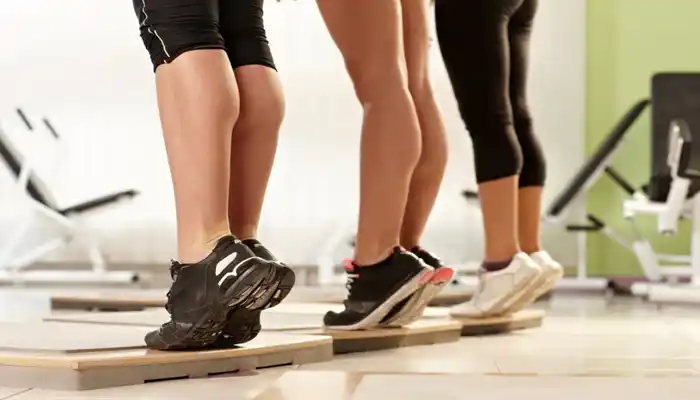
A foundational movement that targets the gastrocnemius, especially effective for building mass and strength. Great for anyone asking how to grow calves at gym or how to grow big calves.
2. Seated Calf Raises
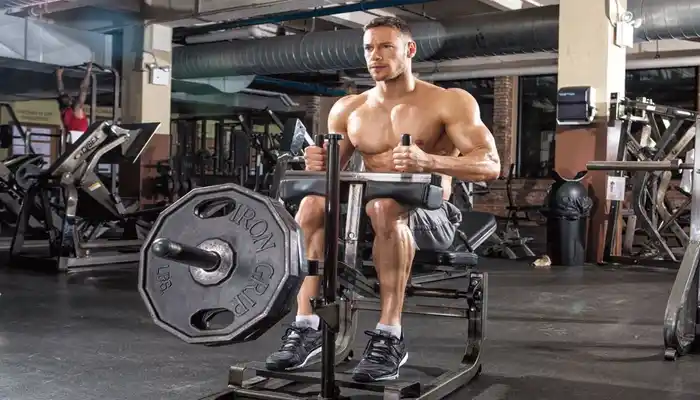
This variation focuses more on the soleus muscle. Use it to improve overall thickness. A must if you’re serious about how to grow calves muscles and not just shape.
3. Leg Press Calf Raises
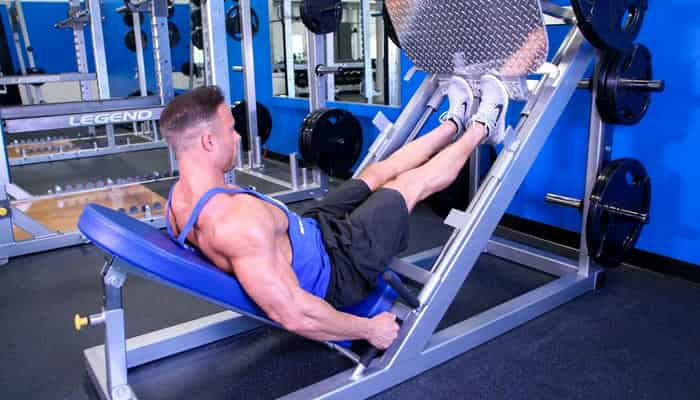
An excellent alternative when standing or seated machines aren’t available. Also great for adding load while maintaining joint stability. Ideal for those training at home gyms or smaller setups.
4. Donkey Calf Raises

A classic bodybuilding movement supported by EMG data for high activation. This targets both heads of the gastrocnemius and is perfect for those learning how to grow inner calves and outer calves.
5. Single-Leg Calf Raises
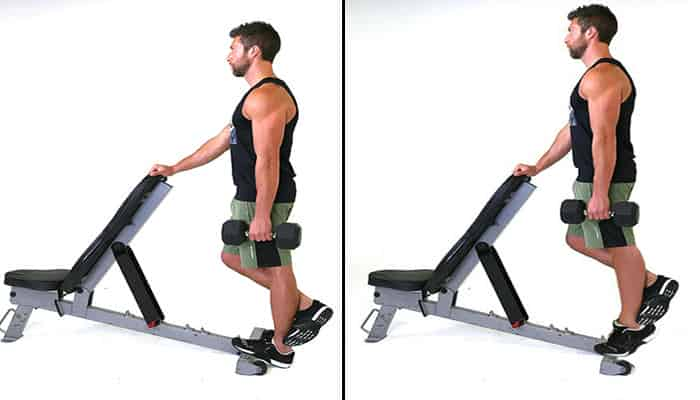
These prevent size imbalances between legs and are ideal for people searching how to grow my calves bigger or how to grow calves evenly.
6. Treadmill Walking on Incline

An underrated technique for how to grow calves on treadmill. Walking uphill or on an incline challenges the calves with continuous tension, especially effective for endurance and long-term shape. Works well for both men and women who prefer low-impact options.
7. Dumbbell Calf Raises
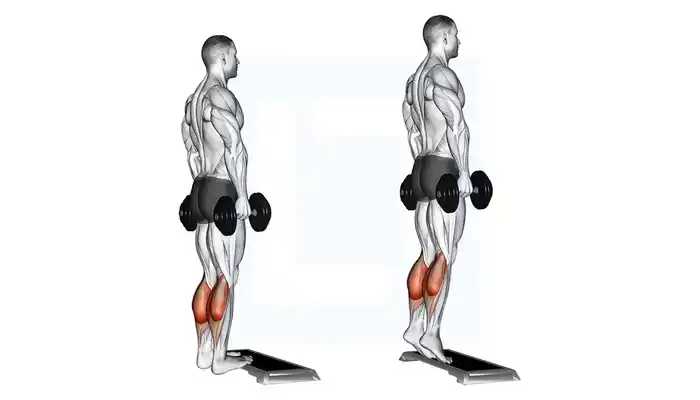
Using dumbbells is a practical choice for how to grow calves with dumbbells or even how to grow calves at home. You can perform these standing on a step or riser to maximize the stretch and contraction.
8. Bodyweight Calf Raises on Step
Highly effective for beginners or those wondering how to grow calves without weights. Focus on high reps and full range of motion to build endurance and size.
9. Floor Raises for Beginners and Women
Great for women new to calf training. If you’re searching how to grow calves women or how to grow calves woman, start with slow, controlled reps of bodyweight raises, gradually adding resistance.
If you’re training at home and lack equipment, bodyweight raises and step-ups on a stair or elevated surface are great options for how to grow calves at home or how to grow calves without weights.
You may also like: Best Sources of Fiber: Must Include Foods For Healthy Gut
The Perfect Calf Training Template
If you’re looking for how to grow calves fast, how to grow calves muscle, or even how to grow calves men, the training frequency, volume, and execution must be dialed in correctly. Here’s how to structure your calf workouts for optimal growth.
Frequency
Train calves 2–3 times per week initially. As your body adapts, increase to 4–5 times weekly. This is crucial for anyone asking how to grow calves faster, especially if you’re dealing with stubborn genetics or want to see quick results.
Sets & Volume
Start with 3–5 sets per session. Over the week, aim for at least 6 sets, scaling up to 15–20+ sets as your tolerance and experience improve.
More volume is especially useful for those researching how to grow calves with bad genetics or how to grow my calves bigger.
Reps
Use higher reps (15–30 per set) to target the slow-twitch soleus muscle, which is endurance-based. But don’t ignore low-rep (6–12) heavy sets—these will hit the gastrocnemius for size and strength.
Higher reps are effective for how to grow calves quickly and how to grow long calves, giving the muscle enough time under tension. Also, your calves are already used to walking which is a high rep low load activity so exposure to heavy weights might yield more results.
Rest Time
Rest 60 seconds or less between sets. Short rest increases metabolic stress and enhances muscle-building hormones. Also calves are not very huge muscles so long rest periods might not give you performance benefits.
Great for time-crunched individuals figuring out how to grow calves at home or in minimalist gym settings.
You may also like: Best Foods for Hair Growth: Foods for Thicker, Healthier Hair
Technique Tips: How to Maximize Calf Gains
Mastering technique is essential if you’re serious about how to grow calves faster, how to grow bigger calves, or simply maximizing each rep. Poor form reduces activation and leads to wasted effort. These cues will help you get the most out of every set—whether you’re training at home, in the gym, or with minimal equipment.
Full Range of Motion
To effectively target both the gastrocnemius and soleus muscles, stretch fully at the bottom and pause at the peak contraction at the top. Avoid bouncing, which shifts the load from the muscles to the tendons, limiting muscle fiber recruitment.
Elevate the Heels for Maximum Stretch
Always perform calf raises on an elevated surface like a step, plate, or riser. This increases the stretch at the bottom and maximizes the range of motion—something flat-ground raises simply can’t offer.
Ideal for those training at home and looking for how to grow calves without weights or how to grow calves at home.
Controlled Tempo for Better Tension
Slow down your reps. Use a 2-second eccentric (lowering) phase and 1–2-second pauses at both the stretched and contracted positions. This significantly increases time under tension, a key driver of muscle growth.
Flex the Quads During Standing Calf Raises
Engage your quadriceps during standing calf exercises to lock your knees and isolate the calves more effectively. This prevents assistance from the hamstrings or glutes and ensures all the effort goes to your lower legs.
Smart Programming: When to Train Calves
Train calves first in your workout, not last. You’ll be mentally fresher, technique will be sharper, and effort will be higher.
You can even add a dedicated “calf day” or include them at the start of upper and lower body sessions.
Advanced Tip: Loaded Stretching
After each calf set, hold a stretch with weight for 15–30 seconds. Studies show this intensifies growth by increasing muscle tension and fascicle length. Try it on your last set of standing calf raises for maximum effect.
You may also like: What is Best Time to Workout? Find Your Ideal Training Time
Lifestyle Tip: Walk More
Regular walking trains the calves in a low-impact, endurance-driven way. Over time, this adds up. Avoid driving short distances—walk instead. This is an excellent long-term strategy for those wondering how to grow calves and ankles.
Special Notes for Different Goals
- How to grow calves muscle vs. strength: Use a mix of high-rep and low-rep training.
- How to grow long calves: You can’t change calf length, but you can improve thickness and definition.
- How to grow bigger calves quickly: Prioritize frequency, loaded stretching, and progressive overload.
Conclusion: How to Grow Calves the Right Way
Calf growth isn’t impossible. It just requires focused effort, smart programming, and consistency.
To summarize:
- Train calves 3–5 times per week
- Use both seated and standing variations
- Prioritize technique, not just weight
- Stretch under load after sets
- Place calves first in your workouts
Whether you’re asking how to grow my calves bigger, how to grow big calves, or simply looking for how to grow calves faster, the answer is commitment, progression, and a strategic approach.
You may also like: The Best Exercise for Weight Loss: Loose Weight Quickly
FAQs (Frequently Asked Questions)
To grow calves, train them 2–3 times per week with a mix of high reps, heavy loads, and full range of motion. Focus on exercises like standing calf raises, seated calf raises, and farmer walks to target the gastrocnemius and soleus muscles.
To grow calves fast, combine high-volume training with progressive overload. Include both bodyweight and weighted movements. To grow calves quickly at home, do high-rep standing calf raises, single-leg calf raises, and stair hops daily. Consistency and frequency are key for faster growth.
To grow calves at home, you can do bodyweight calf raises, jump rope, and step-up exercises. Focus on high reps and controlled movement. You don’t need machines—just stairs, a step platform, or even a thick book for elevation.
If you’re wondering how to grow calves with bad genetics, increase training frequency and volume. Genetics affect muscle shape, not your ability to grow. Use both heavy weight and high reps, and emphasize slow eccentrics and full range of motion.
To grow calves women or grow calves men, the approach is similar. Do calf raises, jump rope, and walking lunges 2–3 times weekly. Whether you’re a man or woman, muscle growth depends on training intensity, frequency, and progressive overload.
The best how to grow calves exercise includes standing and seated calf raises. To build calves muscles and make them bigger, use a combination of light and heavy sets, full stretch at the bottom, and slow negatives. Training consistently is crucial for size gains.
To grow calves without weights, do high-rep bodyweight calf raises, single-leg raises, and jumping rope. Use pauses and slow tempo for added intensity. Train daily or every other day to maximize volume.
To grow calves and ankles, work on both calf muscle mass and ankle strength/stability. Do calf raises, resistance band ankle exercises, and balance drills. Improving ankle strength will also support overall leg development.
To grow long calves, focus on exercises with full stretch and full contraction. You can’t change the length of your muscles, but you can improve thickness and definition through smart programming and consistency.
How long does it take to grow calves? It depends on your training routine, genetics, and nutrition. Visible changes may take 6–12 weeks, but significant size gains often take several months of consistent effort.
To fix skinny calves, increase training volume, focus on time under tension, and train them 2–4 times per week. Use progressive overload and don’t skip seated calf exercises for soleus development.
Are calves easy to build? Not for everyone. Due to daily use, they adapt slowly. But with focused training and enough recovery, they will grow like any other muscle.
Does running increase calf size? It can, especially sprinting or uphill running. However, for maximum hypertrophy, resistance-based calf exercises are more effective.
Do squats grow calves? Not much. Squats target the quads and glutes primarily. Calves are only stabilizers. For real calf growth, you need direct isolation work.
To get taller calves, work on elongating the muscle with full-range movements. Stretching the calves post-workout and using deficit calf raises can enhance the visual length of the muscle.
Calves are hard to grow because they are already highly trained from daily walking and standing. To overcome this, you need high volume, intensity, and variation in your calf training.
Many lifters consider calves to be the hardest muscle to grow due to their dense muscle fibers and frequent daily use. Overcoming this requires progressive overload and consistent targeting.
To know how to grow inner calves, point your toes slightly outward during calf raises. This shifts the emphasis to the inner portion of the gastrocnemius muscle.
To grow outer calves, turn your toes inward during calf exercises. This position targets the outer head of the gastrocnemius and helps improve outer calf thickness.
If you’re searching how to grow calves at gym, use standing calf raise machines, seated calf raises, leg press calf raises, and Smith machine variations for comprehensive growth.
To answer how to grow calves with dumbbells, perform standing or walking calf raises while holding dumbbells to add resistance and build muscle size.
If you’re wondering how to grow calves on treadmill, use incline walking or tiptoe walking to engage the calves. Sprint intervals also help stimulate calf hypertrophy.

